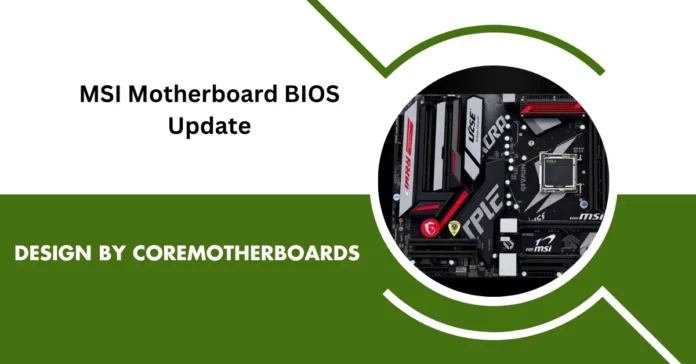Pre-Update Preparation
A. Identify Your Motherboard Model
- Use MSI Dragon Center or CPU-Z (free tool) to detect your model.
- Physically inspect the board: the model number (e.g., “B550M PRO-VDH”) is printed near the PCIe slots.
B. Backup Critical Data
- BIOS updates may reset storage settings. Backup RAID configurations and use MSI BIOS Backup to save your current BIOS.
C. Gather Tools
- Use a USB 2.0 drive (8GB or smaller) formatted to FAT32. Larger drives may fail due to block size issues.
D. Mitigate Risks
- Connect to a UPS to prevent power failure. Disable BitLocker/TPM to avoid boot loops post-update.
BIOS Update Methods
A. M-Flash (In-BIOS Update)
- Download the latest BIOS from MSI’s support page.
- Extract the file to your USB drive.
- Reboot, press DEL to enter BIOS, and select M-Flash.
- Follow prompts, ignoring “BIOS Guard” warnings if the file is verified.
B. BIOS Flashback (No CPU/RAM Required)
- Rename the BIOS file to MSI.ROM.
- Insert the USB into the dedicated Flashback port (white USB 2.0 port on most boards).
- Hold the Flashback button for 3 seconds. The LED blinks during the update.
C. Windows-Based Update (Advanced)
- Use MSI Live Update 6 cautiously. Avoid this method if overclocking or using unstable drivers.
D. Post-Update Steps
- Reset NVRAM via Load Optimized Defaults. Re-enable XMP for RAM and customize fan curves.
Read More : Ultimate Guide to Diagnosing and Fixing the DRAM Light on Your Motherboard
Troubleshooting BIOS Issues
A. Common Errors
- “BIOS Does Not Support EFI Driver”: Disable CSM in BIOS settings.
- USB Not Detected: Reformat the drive using Rufus in non-bootable mode.
B. Recovering a Bricked Board
- Use BIOS Flashback with the renamed MSI.ROM file. For severe cases, reprogram the BIOS chip via the JSPI1 header.
C. MSI Support Resources
- Check EZ Debug LEDs: CPU (red), DRAM (yellow), VGA (white), BOOT (green).
Advanced Topics
Beta BIOS Testing
- Download beta versions from the MSI Forum for early access to features like AGESA 1.2.0.8.
Downgrading BIOS
- Some boards allow rollbacks via M-Flash. If blocked, use Flashback with an older file.
Overclocking Post-Update
- Recalibrate Ryzen Curve Optimizer settings, as updates may reset voltage curves.
FAQs
1. Can I skip BIOS versions?
MSI recommends sequential updates, especially for major CPU upgrades (e.g., Ryzen 5000 on B450).
2. Does a BIOS update improve gaming?
Yes! Enabling Resizable BAR boosted FPS by 8% in Cyberpunk 2077 benchmarks.
4. How often should I update?
Only when necessary—new hardware, critical bugs, or security patches.
Conclusion
Regular BIOS updates keep your MSI motherboard secure and optimized. Use our printable checklist to avoid mistakes.
